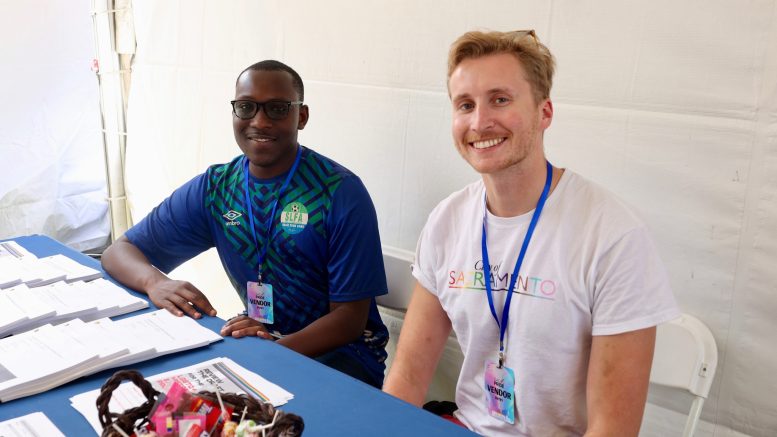By Hannah Ross
The first draft of the LGBTQ+ Historic Experience Project Historic Context Statement (HCS) was unveiled online and at the Sacramento LGBT Community Center’s booth at Sacramento Pride June 8. The document offers the public a preliminary look at the findings of a year-long historical investigation underway with the City of Sacramento’s Community Development Department’s Historic Preservation program.
Similar to the city’s African American Experience Project, conducted last year and recently awarded a California Preservation Foundation award, the LGBTQ+ Historic Experience Project seeks to solidify the presence and impact of a historically marginalized community in the mainstream of Sacramento history.
Henry Feuss, preservation planner for the City of Sacramento, says this document will serve as a framework for future preservation work, providing an important overview of an under-documented history that highlights key sites in local queer history like the headquarters of “Mom, Guess What…!” — Sacramento’s gay and lesbian magazine of the ’70s and ’80s.
“We cannot forget the history that went into getting us to where we are now,” Feuss said, noting that the current climate for LGBTQ+ rights has faced a recent backswing amid a polarizing political climate. As a wave of anti-LGBTQ+ laws have rolled out across the country, Feuss emphasized the importance of solidifying a historic precedent of presence and activism in Sacramento’s history.
“As young people, I feel like so many of us don’t know a lot about our local history … especially as the capital of California, so much happened here. …We have to keep that information alive,” Feuss says.
The HCS will be used to bolster the city archives’ LGBTQ resources, support curriculum building and architectural preservation of landmark buildings across the city, including designating a potential historic district in the Lavender Heights neighborhood if enough material is found to support its geographic significance. It is also an opportunity to diversify a traditionally white-male historical perspective — the project is actively seeking to spotlight a diversity of queer narratives in its HCS.
Crafting a local history for a community that often worked to cover their presence in society has posed many challenges for building a diverse and wide-reaching survey, according to Feuss. To broaden its reach, the Historic Preservation Program has partnered with the Lavender Library, Sacramento’s volunteer-run LGBTQ+ library and community center, to offer stipended research positions conducting oral history interviews, scholarly research with pre-existing archival material, and multimedia production for the project.
Mauricio Torres, vice president of the Lavender Library, says the project offers an exciting opportunity to create a more accessible and “comprehensive” queer history for the whole of the community.
“We have a lot of collections [at the Lavender Library], but where do you start when you just want to learn more about Sacramento’s queer history? … Unless you really spend the time doing all of the background research, and also talking to people, it’s difficult to get a sense of what it was like to be a member of the [LGBTQ+] community at different points in time,” Torres says.
Torres is excited about the energy it will provide the community, recognizing the importance of key spaces and building on an important legacy. “I see this as the first step towards more civic investment in infrastructure that serves the LGBTQ+ community,” he said.
One community volunteer, Carson Anderson, who previously served as the director of the Historic Preservation Program for the City of Sacramento’s Community Development Department before retiring, believes this project is an important effort to “define community” in Sacramento.
In his research, he has found how “fragile and fractious” queer life has been in Sacramento until recently. “People were highly closeted here. … So many people were working in civil service and state and local government and they felt that their jobs were at risk if they came out.”
Often people of color and the transgender community have been left out of queer narratives and history as they faced additional cultural pressures of conformity, according to Anderson who added that this makes it difficult to track down their stories when building historical narratives.
Filling this gap has been a central priority for the project. Anderson, Torres and Feuss all echoed the need for more oral history from queer elders in the community to help bolster these underreported corners.
In addition to flyering, word of mouth, and collaborating with local LGBTQ+ organizations, the project has hosted two community outreach meetings this year, with their next slotted for June 20 at Roscoe’s Bar & Burgers. These meetings create opportunities for community members to provide feedback on the project’s progress and get involved with the work.
“We wanted to make sure that we were capturing the stories that weren’t being told, that hadn’t been told already,” Feuss said. “We fully recognize that there are probably things missing from [the HCS]. …We absolutely want the public to chime in and tell us exactly where we should be looking and filling in those gaps for us.”
Anderson agreed and offered hopes that more people will get involved with the project as volunteers, or in sharing their stories with the community.
“They might be sitting on their own personal stories, thinking them unimportant, but sharing those stories could be so helpful to the team and enriching the historical narrative,” Anderson said. “Sacramento has an interesting history of LGBTQ engagement with civil liberties, public outreach and education, socially and culturally, that needs to be more broadly understood and appreciated. …[We want] people to understand they have a role here, that they might be able to contribute.”
This story is part of the Solving Sacramento journalism collaborative. Solving Sacramento is supported by funding from the James Irvine Foundation and the James B. McClatchy Foundation. Our partners include California Groundbreakers, Capital Public Radio, Outword, Russian America Media, Sacramento Business Journal, Sacramento News & Review, Sacramento Observer and Univision 19.


Be the first to comment on "The LGBTQ+ Historic Experience Project is working to solidify a diverse narrative of Sacramento’s queer history"